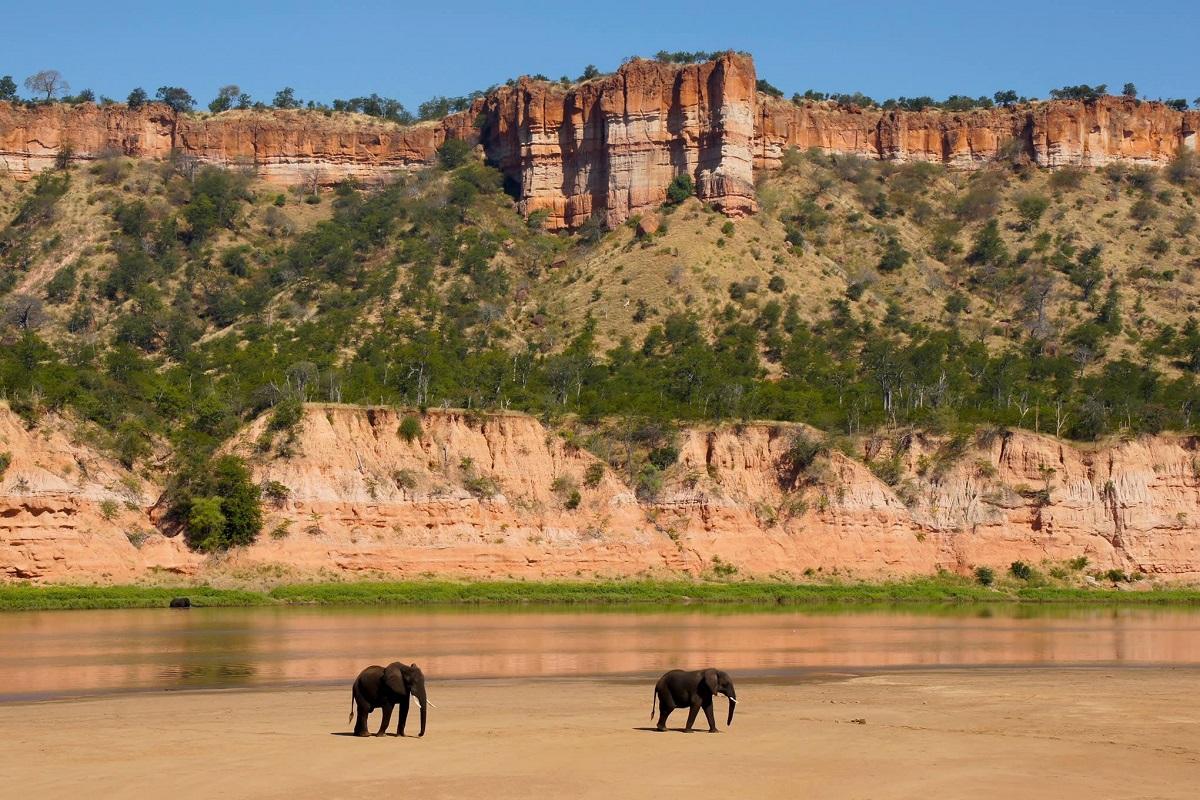Guide to South Gonarezhou: Zimbabwe’s Authentic Safari
Located in southeastern Zimbabwe, South Gonarezhou National Park is a captivating destination that offers visitors an authentic wilderness experience. This expansive park covers about 5,000 square kilometers and is part of the Greater Limpopo Transfrontier Park. This connects it with other conservation areas in Mozambique and South Africa.
The name “Gonarezhou” translates to “place of the elephants” in the local language, and it’s no surprise, as the park is famous for its significant elephant population. Established as a national park in the 1970s, South Gonarezhou is a relatively undiscovered gem that showcases the raw beauty of African landscapes. It features sweeping savannahs, majestic cliffs, and the tranquil Runde River.
For those seeking an off-the-beaten-path adventure, South Gonarezhou offers an incredible opportunity to immerse oneself in nature. You will encounter diverse wildlife and experiencing the rich cultural heritage of the area.
Please Download Our Mobile App here
Overview of the Park
The landscape of South Gonarezhou National Park is diverse, characterized by dramatic cliffs, dense woodlands, and rolling plains. The Chilojo Cliffs, rising over 150 meters above the surrounding savannah, provide stunning views and are a popular highlight for visitors. The Runde River, which flows through the park, creates lush riverine habitats that support various flora and fauna.
The combination of these geographical features results in a vibrant ecosystem that is home to numerous species, including large mammals, birds, and reptiles. The park also harbors important archaeological sites that reflect the historical significance of the region.
You can explore ancient rock art and remnants of early human settlements, providing a glimpse into the cultural richness of the area. With limited tourist infrastructure, South Gonarezhou maintains a sense of solitude, making it an ideal destination for those looking to connect with nature.
Wildlife in the Park
South Gonarezhou National Park is celebrated for its remarkable wildlife, making it a must-visit destination for animal enthusiasts. The park is home to a diverse array of species, including large mammals such as elephants, lions, leopards, and buffalos. The elephant population is particularly notable, with herds frequently roaming the park’s plains, offering breathtaking viewing opportunities for visitors.
Alongside these iconic animals, the park is teeming with various antelope species like kudu, impala, and eland, adding to the park’s rich biodiversity. Birdwatching is also a highlight, as South Gonarezhou is home to over 400 bird species, including raptors, waterbirds, and migratory species, making it a paradise for ornithologists.
The park’s ecosystems, ranging from woodlands to savannahs, provide essential habitats for both resident and migratory wildlife. This ensures that you have the chance to witness dynamic animal behaviours throughout their stay.
Best Time to Visit the Park
The best time to visit South Gonarezhou National Park largely depends on your interests. The dry season, from May to October, is generally considered the prime time for wildlife viewing, as animals gather around limited water sources. During this period, the temperatures are cooler, making for a comfortable safari experience.
The park’s vegetation also thins out, making wildlife easier to spot. The wet season, from November to April, transforms the landscape into a lush paradise, ideal for birdwatchers and those interested in seeing the park’s flora in full bloom.
While wildlife sightings may be less predictable during this time due to denser vegetation. The vibrant colors and the increased activity of migratory birds make it a rewarding time to visit.
Getting to the Park
Accessing South Gonarezhou National Park requires some planning, as it is situated in a remote area of southeastern Zimbabwe. The nearest town is Chiredzi, located about 100 kilometers away from the park’s main entrance. You typically drive from Harare or Bulawayo, with the journey taking approximately six to eight hours depending on road conditions.
It’s essential to have a reliable vehicle, preferably a 4×4, to navigate the sometimes challenging roads. Additionally, hiring a local guide or joining a guided tour can enhance your experience and ensure a smoother journey into the park.
Other Activities in the Park
In addition to wildlife viewing, South Gonarezhou offers a range of activities that allow visitors to connect with the landscape and learn about its ecology and culture. Guided walking safaris provide an intimate experience. This enables guests to explore the park on foot while learning about its flora and fauna from knowledgeable guides.
Birdwatching is another popular activity, as the park is home to an impressive variety of species, particularly during the migratory season. Photography enthusiasts will find numerous opportunities to capture stunning landscapes, including the breathtaking Chilojo Cliffs and the tranquil Runde River. You may also engage with local communities, learning about their traditions and the cultural significance of the land.
Park Fees
The entrance fees for South Gonarezhou National Park are relatively affordable, which enhances its accessibility to a broad range of visitors. Currently, the park charges approximately $10 for international tourists and $5 for Zimbabwean citizens.
Additional fees may apply for guided activities, camping, and accommodation, so it’s advisable to check with local authorities or tour operators for the most accurate and up-to-date information.
FAQs
Is self-driving allowed in South Gonarezhou National Park?
Yes, visitors can self-drive within the park; however, a 4×4 vehicle is recommended due to varying road conditions.
What accommodations are available within the park?
South Gonarezhou offers a few lodges and campsites, providing a range of accommodation options to suit different preferences and budgets.
Are guided walking safaris available?
Yes, guided walking safaris are permitted and highly recommended, allowing visitors to experience the park’s wildlife and ecosystems up close under the supervision of trained guides.
Conclusion
South Gonarezhou National Park is a remarkable destination that offers visitors an unforgettable safari experience in Zimbabwe. Whether you’re drawn to its iconic elephants or the serene beauty of its rivers and cliffs, South Gonarezhou promises a captivating journey into one of Africa’s pristine wilderness areas.
